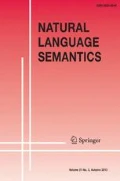Abstract
This paper gives a novel analysis of identificational sentences such as This is Mary, That is a beautiful woman, or This looks like Mary based on the notion of a trope. On that analysis, bare demonstratives in the subject position of an identificational sentence involve reference to a trope as the direct object of perception and the sentence itself states the identification of the bearer of the trope. The analysis also accounts for the semantics of certain specificational sentences such as What John saw was Mary, as well as apparent statements of relative identity such as This is the same lump of clay, but not the same statue as that.
Similar content being viewed by others
References
Beyssade, C., and C. Sorin. 2005. A syntax-based analysis of predication. In Proceedings of SALT 15, ed. E. Georgala and I. Howell, 44–61. Ithaca, NY: CLC Publications.
Birner, B., J.P. Kaplan, and G. Ward. 2007. Functional compositionality and the interaction of discourse constraints. Language 83(2): 317–343.
Brogaart, B. 2010. Do ‘looks’-reports reflect the content of perception? Unpublished manuscript, University of Minnesota.
Caponigro, I., and D. Heller. 2007. The non-concealed nature of free relatives: Implications for connectivity in specificational sentences. In Direct compositionality, ed. C. Barker and P. Jacobson, 237–267. Oxford: Oxford University Press.
Carlson, G. 1991. Cases of really direct reference: Perception or ostention. Handout of a talk given at SALT 1, April 19–21, 1991, Cornell University.
Den Dikken, M. 2006. Relators and linkers. Cambridge, MA: MIT Press.
Den Dikken, M., A. Meinunger, and C. Wilder. 2000. Pseudoclefts and ellipsis. Studia Linguistica 54: 41–89.
Deutsch, H. 2002. Relative identity. In Stanford encyclopedia of philosophy. http://plato.stanford.edu/entries/relative-identity.
Dummett, M. 1973. Frege. Philosophy of language. London: Duckworth.
Dummett, M. 1981. The interpretation of Frege’s philosophy. London: Duckworth.
Fine, K. 2003. The non-identity of a thing with its matter. Mind 112: 195–234.
Geach, P. 1957. Mental acts. New York: Routledge and Kegan.
Geach, P. 1962. Reference and generality. Ithaca, NY: Cornell University Press.
Geach, P. 1972. Identity. In Logic matters, ed. P. Geach, 238–246. Oxford: Blackwell.
Groenendijk, J., and M. Stokhof. 1982. Semantic analysis of wh complements. Linguistics and Philosophy 5: 175–233.
Hamblin, C. 1973. Questions in Montague grammar. Foundations of Language 10: 41–53.
Hawthorne, J. 2003. Identity. In The Oxford handbook of metaphysics, ed. M. Loux and D. Zimmermann, 99–130. Oxford: Oxford University Press.
Heal, J. 1997. Indexical predicates and their uses. Mind 106: 619–640.
Heim, I. 1982. The semantics of definite and indefinite noun phrases. PhD dissertation, University of Massachusetts at Amherst.
Heller, D. 2005. Identity and information: Semantic and pragmatic aspects of specificational sentences. PhD dissertation, Rutgers University.
Heller, D., and L. Wolter. 2008. That is Rosa. Identificational sentences and intensional predication. In Proceedings of Sinn und Bedeutung, vol. 12, ed. A. Grønn, 226–240. Oslo: University of Oslo.
Heycock, C., and A. Kroch. 1999. Pseudocleft connectedness: Implications for the LF interface levels. Linguistic Inquiry 30: 365–397.
Higgins, F.R. 1973. The pseudo-cleft construction in English. Bloomington, IN: Indiana University Linguistics Club.
Jacobson, P. 1994. Binding connectivity in copula sentences. In Proceedings of SALT 4, ed. M. Harvey and L. Santelmann, 161–178. Ithaca, NY: CLC Publications.
Jacobson, P. 1995. On the quantificational force of English free relatives. In Quantification in natural languages, ed. E. Bach et al., 451–487. Dordrecht: Kluwer.
Kamp, H. 1981. A theory of truth and representation. In Truth, interpretation and information, ed. J. Groenendijk et al., 4–41. Dordrecht: Foris.
Karttunen, L. 1978. The syntax and semantics of questions. Linguistics and Philosophy 1: 3–44.
Kratzer, A. 1998. Scope or pseudo-scope? Are there wide-scope indefinites? In Events in grammar, ed. S. Rothstein, 163–196. Dordrecht: Kluwer.
Levine, J. 2010. Demonstrative thought. Mind and Language 25(2): 169–195.
Levinson, J. 1980. The particularization of attributes. The Australasian Journal of Philosophy 58: 102–115.
Lowe, E.J. 1998. The possibility of metaphysics. Oxford: Oxford University Press.
Lowe, E.J. 2007. Sortals and the individuation of objects. Mind and Language 22(5): 514–533.
Lowe, E.J. 2008. Tropes and perception. In Tropes, universals and the philosophy of mind: Essays at the boundary of ontology and philosophical psychology, ed. S. Gozzano and F. Orilia, 175–192. Frankfurt: Ontos Verlag.
Mikkelsen, L. 2004. Specifying who: On the structure, meaning, use of specificational copula sentences. PhD dissertation, University of California, Santa Cruz.
Moltmann, F. 1992. Reciprocals and same/different. Towards a semantic analysis. Linguistics and Philosophy 15: 411–462.
Moltmann, F. 2009. Degree structure as trope structure. A trope-based approach to the semantics of positive and comparative adjectives. Linguistics and Philosophy 31: 51–94.
Moro, A, 1997. The raising of predicates and the theory of clause structure. Cambridge: Cambridge University Press.
Partee, B. 1986. Ambiguous pseudoclefts with unambiguous be. In Proceedings of NELS 16, ed. S. Berman et al., 354–366. Amherst, MA: GLSA.
Perry, J. 1970. The same F. The Philosophical Review 79(2): 181–200.
Quine, W.V.O. 1964. Review of reference and generality. The Philosophical Review 73: 100–104.
Reinhart, T. 1997. Quantifier scope: How labour is divided between QR and choice functions. Linguistics and Philosophy 20: 335–395.
Romero, M. 2005. Concealed questions and specificational subjects. Linguistics and Philosophy 25: 687–737.
Schlenker, P. 2003. Clausal equations (A note on the connectivity problem). Natural Language and Linguistic Theory 21: 157–214.
Schnieder, B. 2004. A note on particularized qualities and bearer-uniqueness. Ratio 17: 218–228.
Sharvit, Y. 1999. Connectivity in specificational sentences. Natural Language Semantics 7: 299–304.
Williams, D.C. 1953. On the elements of being. Review of Metaphysics 7: 3–18.
Williams, E. 1983. Syntactic vs. semantic categories. Linguistics and Philosophy 6: 423–446.
Winter, Y. 1997. Choice functions and the scopal semantics of indefinites. Linguistics and Philosophy 20: 399–467.
Woltersdorff, N. 1970. On universals. Chicago: The University of Chicago Press.
Author information
Authors and Affiliations
Corresponding author
Rights and permissions
About this article
Cite this article
Moltmann, F. Identificational sentences. Nat Lang Semantics 21, 43–77 (2013). https://doi.org/10.1007/s11050-012-9091-4
Published:
Issue Date:
DOI: https://doi.org/10.1007/s11050-012-9091-4




